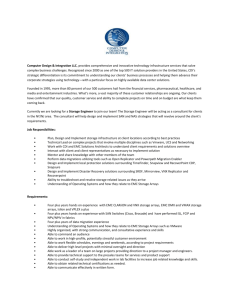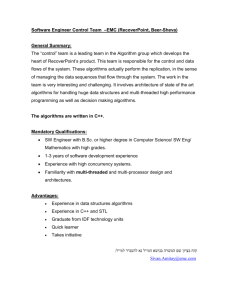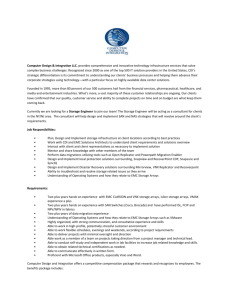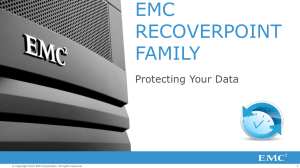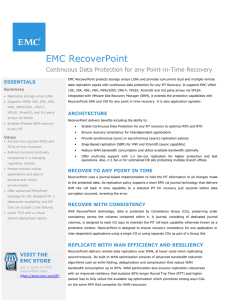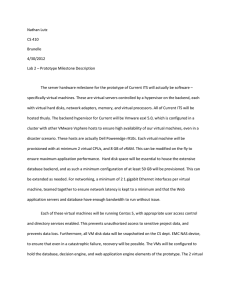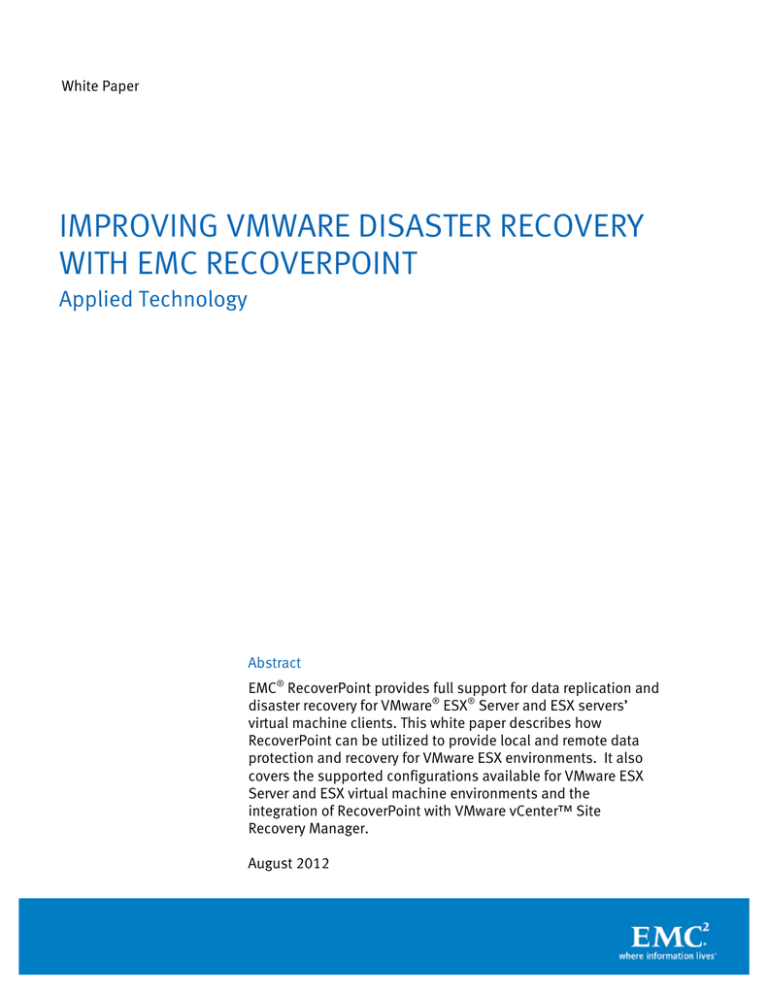
White Paper
IMPROVING VMWARE DISASTER RECOVERY
WITH EMC RECOVERPOINT
Applied Technology
Abstract
EMC® RecoverPoint provides full support for data replication and
disaster recovery for VMware® ESX® Server and ESX servers’
virtual machine clients. This white paper describes how
RecoverPoint can be utilized to provide local and remote data
protection and recovery for VMware ESX environments. It also
covers the supported configurations available for VMware ESX
Server and ESX virtual machine environments and the
integration of RecoverPoint with VMware vCenter™ Site
Recovery Manager.
August 2012
Copyright © 2006, 2012 EMC Corporation. All Rights Reserved.
EMC believes the information in this publication is accurate of
its publication date. The information is subject to change
without notice.
The information in this publication is provided “as is”. EMC
Corporation makes no representations or warranties of any kind
with respect to the information in this publication, and
specifically disclaims implied warranties of merchantability or
fitness for a particular purpose.
Use, copying, and distribution of any EMC software described in
this publication requires an applicable software license.
For the most up-to-date listing of EMC product names, see EMC
Corporation Trademarks on EMC.com.
VMware, ESX, vMotion, VMware vCenter, and VMware View are
registered trademarks or trademarks of VMware, Inc. in the
United States and/or other jurisdictions. All other trademarks
used herein are the property of their respective owners.
Part Number h2352.7
Improving VMware Disaster Recovery with EMC RecoverPoint
2
Table of Contents
Executive summary .................................................................................................................................. 4 Introduction ............................................................................................................................................. 4 Audience ................................................................................................................................................. 4 Support for VMware ................................................................................................................................. 4 Array-based write splitting ................................................................................................................ 5 Host-based write splitting ................................................................................................................. 5 Intelligent fabric support .................................................................................................................. 6 Choosing your RecoverPoint splitter.................................................................................................. 6 Using VMware vCenter Site Recovery Manager ...................................................................................... 7 Integration with RecoverPoint ........................................................................................................... 8 Automation and testing .................................................................................................................... 9 VAAI support ...................................................................................................................................... 10 VMware affinity .................................................................................................................................. 11 Replication configurations .................................................................................................................. 12 Conclusion............................................................................................................................................. 12 References ............................................................................................................................................. 12 Improving VMware Disaster Recovery with EMC RecoverPoint
3
Executive summary
EMC® RecoverPoint is an advanced enterprise-class disaster recovery solution
supporting heterogeneous storage and server environments. RecoverPoint provides
bi-directional local and remote data replication across any distance, and utilizes
continuous data protection technologies to provide consistent point-in-time recovery.
RecoverPoint helps customers accelerate protection and provides operational and
disaster recovery of their VMware® Infrastructure, without impacting production
environments. RecoverPoint is ideally suited for replicating and protecting physical
and virtual server environments.
Introduction
Server virtualization technology allows one physical server platform to run multiple
virtual machines simultaneously. Many customers have taken advantage of server
virtualization, such as that provided by VMware ESX®, to consolidate their server
infrastructure and simplify their disaster recovery platforms. These customers may
have also invested in an enterprise-class SAN to support their primary data center
and disaster recovery sites. This leads to some challenges when it comes to
managing data protection for their local and remote data centers, especially for
applications running on a virtual machine in an ESX server.
This white paper describes how customers can utilize RecoverPoint to enhance the
disaster recovery and data protection capabilities of their physical and virtualized
VMware applications with local and remote replication. RecoverPoint supports
vSphere 4.x and vSphere 5.x. RecoverPoint supports VMware vCenter Site Recovery
Manager 4.x and 5.x. When you use RecoverPoint you are not required to install
VMware HA or DRS.
Audience
This white paper is targeted to VMware storage and server administrators, IT
managers, and storage professionals, as well as integrators, consultants, and
distributors.
RecoverPoint support of VMware
RecoverPoint supports the local and/or remote replication of iSCSI and SAN-attached
volumes. RecoverPoint supports RDM and VMFS 3/5 volumes and if the VMware ESX
server is configured for boot from SAN (BFS), then the boot volumes can also be
replicated to the remote site. RecoverPoint captures changes to data by intercepting
every write (either to an RDM volume or to a VMFS volume) that reaches the SAN
Improving VMware Disaster Recovery with EMC RecoverPoint
4
Array-based write splitting
RecoverPoint supports write splitting for VMware VMs on VMFS and RDM volumes for
the Symmetrix VMAX 40K, 20K, 10K, Symmetrix VMAXe, VPLEX Local, VPLEX Metro,
VNX series and CLARiiON CX3 and CX4 arrays. The RecoverPoint Symmetrix write
splitter supports Symmetrix VMAX 40K, 20K and 10K with Enginuity 5876 and
Symmetrix VMAXe with Enginuity 5875. The VPLEX write splitter is a feature of
GenSyncrony 5.1, the VNX/CLARiiON write splitter is supported on VNX OE R31 or
higher and on FLARE® 26, 28, 29, and 30. The splitter supports Fibre Channel (FC)
volumes presented by the array to any host, including to an ESX server. The
VNX/CLARiiON RecoverPoint write splitter also supports iSCSI volumes.
The RecoverPoint write-splitter operates in each array where it monitors writes to
protected volumes and ensures that the RecoverPoint appliance receives a copy of
the write. Up to four RecoverPoint clusters can be attached to the same VPLEX, VNX
series or CLARiiON array and up to six RecoverPoint clusters can be attached to the
same Symmetrix VMAX family or Symmetrix VMAXe family array. A benefit of this is
that multiple production sites can use the same array such as might exist in a shared
disaster recovery site or at a service provider’s site.
Figure 1. Splitter architecture
Host-based write splitting
RecoverPoint provides a host-based write splitter (also called a KDriver) for Windows
Server platforms that is supported with VMware. For VMware, the KDriver is installed
on each Windows virtual machine where it operates above any multipath driver, but
below the file system and volume management layers. The KDriver monitors writes
and ensures that a copy of all writes to a protected volume is sent to the RecoverPoint
appliance. Since the KDriver runs in the virtual machine, the only volumes that can be
replicated by RecoverPoint would be SAN volumes attached to the virtual machine in
physical RDM mode (RDM/P).
Improving VMware Disaster Recovery with EMC RecoverPoint
5
Intelligent fabric support
RecoverPoint write splitting is also provided through intelligent fabric APIs provided
on EMC Connectrix switches using Brocade and Cisco technology. For VMware,
RecoverPoint supports the Brocade Storage Application Services APIs on the
Connectrix AP-7600B switch. Also supported is the Cisco SANTap APIs provided on
the Connectrix Storage Services Module and the MDS 18/4 Multi-Services Blade,
either of which can be installed in a Connectrix MDS-9000 director family, or in the
Connectrix MDS-9222i switch. For replication, VMFS volumes as well as volumes
attached to the virtual machine in physical RDM mode (RDM/P) are supported.
For EMC block storage, EMC recommends that the array-based write splitter be
utilized and that for non-EMC block storage, EMC recommends that a VPLEX be used
in front of the non-EMC storage, and that the virtual volumes are replicated with the
VPLEX RecoverPoint write splitter.
Choosing your RecoverPoint splitter
The following table summarizes the VMware features and limits for each of the three
write-splitting technologies supported by RecoverPoint.
Array-based write splitter
As this table shows, the array-based write splitter is the most effective configuration
for VMware replication, which is why it is recommended. With an array-based write
splitter, any of the RDMs or volumes containing VMFS 3/5 can be replicated. The only
restriction on the write splitter is that all of the volumes for a specific VM must reside
on array or platforms that are supported by and attached to the RecoverPoint
appliance.
Host Splitter Configuration
For this configuration, the RecoverPoint host splitter is installed on each virtual
machine that has data that needs to be replicated. There are a few limitations on the
host driver. First, it only supports the Windows platforms; second, only the virtual
machines’ data can be replicated, and it must be attached as a RDM/P volume, and
the boot volumes are not replicated; third, only a maximum of 255 guest machines
per ESX server can be supported for replication, which is a VMware restriction; and
fourth only RecoverPoint/CL is supported.
Table 1. RecoverPoint splitter comparisons
Splitter
Features
Array-based write splitter
(VMAX 40K, 20K, 10K,
VMAXe, VPLEX, VNX,
CLARiiON)
Supports physical
YES
RDM
Supports virtual RDM YES
Windows host
write splitter
Brocade/Cisco
Intelligent Fabric
write splitter
YES
YES
NO
YES
Improving VMware Disaster Recovery with EMC RecoverPoint
6
Splitter
Features
Supports VMFS 3
Supports VMFS 5
Supports VMotion®
Supports HA/DRS
Supports vCenter™
Site Recovery
Manager
Supports P2V
replication
Supports V2V
replication
Supports guest OS
BFS
Supports ESX BFS
Maximum number of
LUNs supported per
ESX server
Array-based write splitter
(VMAX 40K, 20K, 10K,
VMAXe, VPLEX, VNX,
CLARiiON)
YES
YES
YES
YES
Windows host
write splitter
Brocade/Cisco
Intelligent Fabric
write splitter
NO
NO
NO
NO
YES
YES
YES
YES
YES
NO
YES
RDM/P and VMFS
RDM/P only
RDM/P and VMFS
RDM/P and VMFS
RDM/P only
RDM/P and VMFS
RDM/P and VMFS
RDM/P only
RDM/P and VMFS
YES
NO
YES
N/A
255 (VMware
restriction)
N/A
EMC Symmetrix VMAX 40K, EMC VNX,
20K, 10K, Symmetrix
CLARiiON CX™,
Heterogeneous array
VMAXe, VPLEX, VNX and Symmetrix® and EMC+3rd Party
support
selected 3rd-party
CLARiiON CX3/CX4+3rd
storage
party with VPLEX or FTS
Can be shared
between
YES
NO
NO
RecoverPoint clusters
Intelligent Fabric-based write splitter
The last configuration uses intelligent fabric splitting, which is provided on some
Brocade and Cisco director-class switches. Using intelligent fabric splitting the
volumes can reside anywhere in the SAN. Intelligent fabric splitting enables the
replication of ESX boot volumes, virtual machine boot volumes (either as physical
RDM volumes or as a VMFS volume), and virtual machine data volumes (either as
physical RDM volumes or as VMFS volumes).
Using VMware vCenter Site Recovery Manager
VMware vCenter SRM automates the recovery process so it becomes as simple as
pressing a single button. There is no need for the user to interact with the
RecoverPoint console and the VMware console; instead VMware automates the
Improving VMware Disaster Recovery with EMC RecoverPoint
7
process. All the user has to do is ensure that the production virtual machines are
mapped to LUNs that are replicated by RecoverPoint to the remote site.
SRM leverages RecoverPoint to provide external replication solution between
protected and recovery sites. The workflow that is built into SRM automatically
discovers the datastores that are set up for replication between the protected and
recovery sites. You can configure SRM to support bi-directional protection between
the two sites.
RecoverPoint sits below the VMware Infrastructure and is responsible for replicating
all changes from the production LUNs to the remote replicate LUNs at the disaster
recovery site. The RecoverPoint storage replication adapter is installed on the same
servers that are running vCenter Server and the vCenter Server Site Recovery Manager
plug-in in the production and disaster recovery sites.
The benefits of RecoverPoint are that the replication can be between differing arrays,
such as between a Symmetrix and a VNX series or between an EMC storage array and
a Non-EMC storage array. There is no requirement that the production volumes be
attached to the VMware servers in RDM/P mode; instead the data can reside on VMFS
file systems that are contained on the production LUNs. Finally, with RecoverPoint
the distance between the sites is not a limit, since RecoverPoint replicates the data
asynchronously but maintains the write-order consistency at the remote site, ensuring
that all replicas remain fully consistent.
Integration with RecoverPoint
VMware vCenter Site Recovery Manager is designed as a plug-in to VMware vCenter
Server so that the SRM disaster recovery tasks can be executed inside the same
management tool as other VM administration tasks such as creation, migration, and
deletion. VMware vCenter SRM is highly automated and is responsible for the setup,
test, and recovery workflows for disaster recovery automation. SRM enables you to
accelerate recovery and ensure successful recovery by automating the recovery
process and eliminating the complexity of managing and testing recovery plans.
VMware vCenter SRM eliminates complex manual recovery steps and removes the risk
and worry from disaster recovery.
VMware vCenter SRM reduces the RTO for disaster recovery and relies on
RecoverPoint to reduce the RPO for disaster recovery. To implement replication,
RecoverPoint maps the VMware vCenter SRM requests into the appropriate
RecoverPoint actions.
Improving VMware Disaster Recovery with EMC RecoverPoint
8
Figure 2. VMware vCenter Site Recovery Manager
All of the benefits of RecoverPoint discussed in this paper also apply when VMware
vCenter SRM uses RecoverPoint for replication. This includes benefits such as the
use of the various RecoverPoint write splitters, heterogeneous storage and policybased replication. SRM is designed for site-to-site replication, as such it only works
with remote replication as provided by RecoverPoint CRR, or if continuous local and
remote data protection is being used, SRM will only operate with the remote replica
copy. The local (or CDP) copy of a CLR consistency group will be unaffected by the
SRM operations and will remain available for use; however, RecoverPoint will pause
the transfer to the local copy until production is resumed at the protected site.
Automation and testing
Testing disaster recovery plans and ensuring that they are executed correctly are
critical to making recovery reliable. However, testing is difficult with traditional
solutions due to the high cost, complexity, and disruption associated with tests.
Another challenge is ensuring that staff are trained and prepared to successfully
execute the complex process of recovery.
VMware vCenter SRM is not a replication technology but a technology that manages
the processes and automation steps in recovery. It uses RecoverPoint to replicate
data from the primary site to the secondary site. SRM recovery plans leverage
RecoverPoint’s image access capability to nondisruptively test the failover process to
ensure that the secondary image is consistent and usable.
Improving VMware Disaster Recovery with EMC RecoverPoint
9
Figure 3. VMware vCenter Site Recovery Manager
The previous figure shows what the architecture looks like once SRM has been
installed and configured with RecoverPoint to support the VMware Infrastructure
environment. For a brief video chalk talk see EMC and VMware: The Ultimate Disaster
Recovery Solution at
http://www.emc.com/collateral/demos/microsites/mediaplayer-video/video-bakertothepoint.htm.
VAAI support
VMware vSphere™ 4.1 introduced the vStorage API for Array Integration (VAAI), which
speeds up certain VMware operations by offloading them to array-based hardware. By
default, all VAAI commands are enabled when upgrading to or installing ESX/ESXi™
4.1 and later. If the RecoverPoint splitter does not support a particular VAAI
command, this VAAI command must be disabled on all ESX servers in the vSphere
cluster before presenting datastores to ESX hosts. The VAAI commands are:
•
Full copy: Can significantly speed up the process of deploying virtual machines.
Implemented via the xcopy SCSI command.
•
Block zero: May speed up bulk zeroing of a disk. Also called copy same.
•
Hardware-assisted locking: Implements a LUN locking mechanism that is more
efficient in the clustered host environment. Also called Atomic Test and Set.
Implemented using the Compare and Swap SCSI command.
•
UNMAP: Allows the ESXi host to inform the storage array that files or VMs had
be moved or deleted from a Thin Provisioned VMFS datastore. Added as a
VAAI command in vSphere 5.0U1.
Improving VMware Disaster Recovery with EMC RecoverPoint
10
Notice: Failure to disable an unsupported VAAI command may lead to data
corruption, production data being unavailable to ESX hosts, degraded performance,
or switch reboot.
RecoverPoint splitters support each VAAI command at one of the following levels:
•
•
•
Unsupported. If the RecoverPoint splitter does not support a particular VAAI
command, it must be disabled on all ESX servers. Failure to disable an
unsupported VAAI command may lead to data corruption, production data being
unavailable to ESX hosts, degraded performance, or switch reboot.
Blocking. When RecoverPoint blocks or rejects the use of a VAAI command,
VMware automatically immediately reverts to legacy behavior, with no risk to data
or performance.
Supported. RecoverPoint supports the VAAI command and its functionality.
Table 2. VAAI commands supported by RecoverPoint, according to write-splitter type
Feature
Full copy
Block zeroing
Hardwareassisted locking
UNMAP –
vSphere 5.0U1
and later
Windows write
splitter
Brocade write
splitter
Cisco-SANTap
write splitter
Array-based write
splitter
Unsupported
Unsupported
Unsupported
Blocked
Blocked
Blocked
Blocked
Blocked
Blocked
Blocked
Blocked
Supported
Unsupported
Blocked
Blocked
Supported on
VNX arrays with
OE R32
otherwise
Blocked
VMware affinity
In the RecoverPoint Management Application GUI the user can view ESX servers and
all their virtual machines, datastores, and RDM drives. This view also displays the
replication status of each volume
For virtual machines that are partially protected by RecoverPoint, the administrator
can modify existing RecoverPoint consistency groups to add a replication set
containing the unprotected volume. For virtual machines that are not protected by
RecoverPoint, the administrator can create a new consistency group with a replication
set for each volume not configured for replication.
Any change to virtual machines’ protection status, such as moving from being fully
protected to being partially protected, will result in RecoverPoint logging and raising
an alert. Additionally, all of the information shown on the Management Application
GUI for each virtual machine can be queried though the RecoverPoint CLI.
Improving VMware Disaster Recovery with EMC RecoverPoint
11
Replication configurations
RecoverPoint will protect VMware ESX Server virtual machines in the following
configurations:
•
•
•
•
•
•
•
Replication of a physical server to a local and/or remote standby virtual machine
Replication of a virtual machine to a local and/or remote virtual machine
Replication of a physical server to a remote standby physical server with local replication to a
standby virtual machine
Replication of a virtual machine in one or more ESX servers to local and remote physical machines
Replication of a virtual machine to a remote virtual machine with failover automation provided by
VMware vCenter SRM
Replication of VPLEX virtual volumes that contain one or more virtual machines to a local and/or
remote volume
Replication of VPLEX virtual volumes that contain one or more virtual machines to a remote volume
with failover automation provided by VMware vCenter SRM
Conclusion
The innovative technology of EMC RecoverPoint supports flexible levels of protection,
without distance limitations and performance degradation. With its unique
architecture, powerful data recovery features, and business-driven approach,
RecoverPoint offers superior levels of local and remote data protection and business
continuity to organizations running VMware ESX.
References
More information on EMC RecoverPoint can be found at the RecoverPoint page on
EMC.com and in the following documents on the EMC Powerlink website:
•
•
•
•
•
•
•
Introduction to EMC RecoverPoint 3.5: New Features and Functions — Applied Technology
Improving Microsoft Exchange Server Recovery with EMC RecoverPoint — Applied
Technology
EMC RecoverPoint Family Overview — A Detailed Review
EMC RecoverPoint Replicating VMware ESX Technical Notes (Powerlink only)
Using EMC RecoverPoint Concurrent Local and Remote for Operational and Disaster
Recovery – Applied Technology
Solving Data Protection Challenges with EMC RecoverPoint – Best Practices Planning
EMC RecoverPoint Adapter for VMware vCenter Site Recovery Manger Release Notes
(Powerlink only)
Improving VMware Disaster Recovery with EMC RecoverPoint
12

